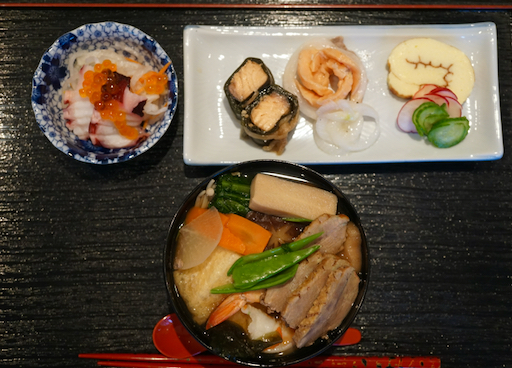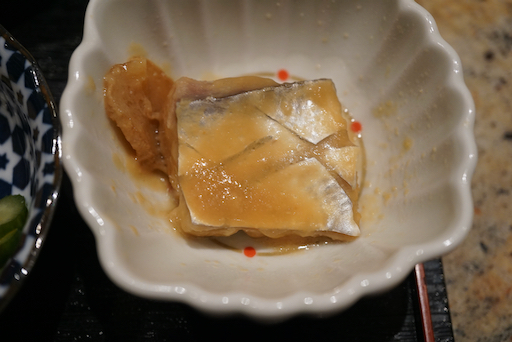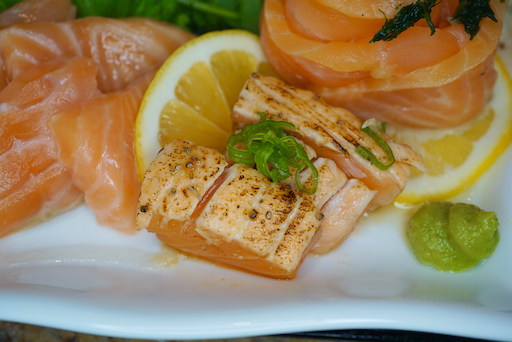For New Year's eve, we started with this sashimi. I ordered Atlantic tuna toro 鮪とろ, octopus leg 蛸, and ikura イクラ (all frozen) from Catalina offshore products at least a month ahead of time because last year I waited too long and when I got around to ordering sashimi for New Year they were sold out. I also got sashimi-grade salmon but it was a large piece and would have been too much so I did not thaw it. The toro piece was small (5oz) but enough for two of us. It contained "ootro" 大トロ and small portion of "chutoro" 中トロ. The octopus legs appeared to have been imported from Japan.
Wednesday, January 13, 2021
New year's eve sashimi 2020 年越しの刺身
Friday, January 1, 2021
Happy New Year 2021 あけましておめでとう2021
The year 2020 was a quite taxing year. We hope things will get better in 2021, although we are, by no means, out of woods. Because of Covid, we stopped going to our Japanese grocery store (or many other stores for that matter). Having home delivery was a God-send. Nonetheless, however, we were not able to get all of our usual New Year food items or decorations including "Kagami-mochi" 鏡餅. (There may be a silver lining in this since we almost never eat all the small round mochi contained in it). So, this year our New Year's display was absent the Kagami-mochi. We only displayed the zodiac animal figurines representing the year--which in this case was the Ox. The pictures below show our collection of zodiac oxen. The smallest guy, in front, looks like a holstein cow and is made of painted wood. The one standing behind and looking at him is made from "do-rei" 土鈴 or earthenware and is actually a bell.
Saturday, December 19, 2020
Appetizers 4 kinds お通し4種類
Ingredients:
3 Japanese eggplant
2 tbs neutral vegetable oil
two small pieces of ginger, crushed with the side of the knife.
250ml Japanese dashi broth (I made this with my usual bonito and kelp dashi pack)
3 tbs soy sauce
3 tbs mirin
(Instead of soy sauce, I am using "shirodashi" 白だしand light colored soy sauce).
Directions:
Cut the eggplants in half lengthwise. Shallowly cut the skin in crosshatching pattern and then cut lengthwise again to make 1/4 eggplant.
Add the oil to a frying pan on medium flame and add the ginger for a few minutes until fragrant.
Add the eggplants skin-side down and fry for 3-4 minutes and turn over to fry both of the fresh sides for 2-3 minutes each,
Add the seasonings and broth (below), put on the lid and simmer for 3-4 minutes.
This is good eaten hot right after it is cooked but it can also be stored in the broth in a sealable container in the refrigerator. The stored eggplant can be eaten cold or heated up in the microwave.
This is usual salmon nanban. This one was really good since the quality of the salmon (from Whole foods) was good and I did not over cook it. I served this with sugar snap in salt broth スナップ豌豆の塩びたし.
Mr. and Mrs. Segawa of Tako Grill kindly gave us "kazunoko" herring roe 数の子. I prepared it as I described in my New Year dish tab. The half serving shown below was soaked in dashi broth with soy sauce and mirin seasoning. I marinated the other half serving in sake-lee and miso mixture or "kasu-miso" 粕味噌. Since this preparation will last longer than the one soaked in dashi broth we will eat it closer to the holidays.
I also served Spanish mackerel in miso sauce 鯖の味噌煮. (The red dots surrounding the mackerel are part to the decoration of the bowel not part of the preparation.)
This was a quite a good starter line up for the evening.
Monday, July 13, 2020
No knead rye bread 捏ねないライ麦パン

Friday, July 10, 2020
Salmon sashimi 4 ways 鮭の刺身4種類
Thursday, May 14, 2020
Three "otoshi" appetizers お通し3種
The left and below are Fried salmon in sweet vinegar 鮭の南蛮漬け. I added salt-broth soaked snap peas スナップ豌豆の塩びたし.
Digression alert: because of social distancing during the covid-19 crisis I have not been able to go to the Japanese grocery store and I was running short of rice vinegar. I bought what I thought was rice vinegar at the regular grocery store but it turned out to be basil and oregano flavored rice vinegar (?!!) I used it in this dish anyway and it actually added a very nice flavor dimension that was an interesting twist on the traditional. We actually liked it. I may have to stock in basil flavored rice vinegar...heaven forbid.
In the dish below I used brazed crunchy cauliflower モンパルナスのカリフラワー炒め, blanched broccoli with sesame sauce ブロッコリの胡麻よごし, and Japanese style omelet with "aonori" 青海苔入りだし巻き.
This dish is braised cabbage, onion, and strips of agura-age or deep dried tofu pouch seasoned with soy sauce and mirin, I posted similar ones with daikon green.
All simple Izakaya affairs but perfect opening of the evening with cold sake.
Thursday, March 26, 2020
Salmon cake サーモンケーキ
Ingredients:
3 small salmon filets, cooked and skin (removed) (eaten previously while still crispy after salmon was first cooked). Crush them in a Ziploc bag to make small flakes.
6 frozen raw shrimp (I used Argentinean red shrimp), thawed, shelled, and made into a paste by chopping them finely with a chef's knife.
1/2 onion, finely chopped and sautéed in olive oil until transparent, let it cool.
1 tbs chopped fresh dill
Salt and pepper for seasoning
For dredging
flour, egg water and Panko bread crumbs
Oil for deep frying
Directions:
Mix the ingredients. I was not sure if I would have to add more binders such as flour and egg but the shrimp paste worked well and I could make small cakes (#1) without much difficulty. I dredged them in flour, egg water and Panko (#2). Deep fried for a few minutes turning occasionally until golden brown and cooked through (the only ingredient that needed to be cooked was the shrimp paste) (#4).
This was a sort of proof of concept but the shrimp paste really worked well as a binder without adding strong flavor of its own. Making salmon cakes this way may be a bit of work as compared to using uncooked salmon or making salmon salad but it is another good way to use leftover cooked salmon. Drying the filets intensifies the flavor in a very good way. The cakes reheated nicely in the toaster oven making a very nice appetizer. Great snack to start the evening.
Thursday, March 19, 2020
Six "otoshi" appetizers お通し6種類
The upper row from left to right are Chinese-style squid salad (store-bought) with my sugar snap in salt broth, grilled fish cake (store bought) with blanched broccolini dressed in mustard soy sauce, Russian marinated salmon (leftover from the previous evening). (It had been marinading for 2 days by then). The lower row from left to right are octopus leg, cucumber slices and Campari tomato dressed in sumiso sauce and "mizuna" oshitashi 水菜のお浸しtopped with bonito flakes.
Although it missed the group picture, the sixth appetizer was; salmon sashimi and avocado cubes dressed in soy sauce, sesame oil, chiffonade of perilla and finely chopped garlic. The salmon was leftover from the prior evening. I made a slight modification by salting one side and searing it with a kitchen torch before cutting it into cubes. This added an additional grilled flavor and slight crusty texture.
The dish shown below is Chinese-style squid salad 中華風イカサラダ bought at our Japanese grocery store. The variation of this appears to be available at Catalina offshore products as well.
Below is a small deep fried fish cake which is almost always available at our Japanese grocery store. This appears to be locally made and is pretty good. We heat it up in the toaster oven. I dressed blanched broccolini florets with mustard soy sauce (I now make several Japanese sauces in small squeeze bottles and store them in the refrigerator for instant use).
This was leftover Russian marinaded salmon I made the night before. This marinaded a total of 2 days and was almost completely "chemically" cooked but the onion was better now (marinating just overnight, the sweet onion was a bit too raw). I topped this with salmon roe and garnished it with perilla.
The dish below came about due to a mistake I made. I thought I got a bunch of edible chrysanthemum 春菊 but instead it was Japanese mizuna 水菜. I blanched it very quickly for 20 seconds, drained and cooled it down by fanning and squeezed out the moisture (I did this in the morning and kept it in a Ziploc bag in the fridge.) I made this to "ohitashi" お浸し("hitasu" in Japanese is to "soak", I made the sauce with equal parts Japanese dashi and concentrated noodle sauce and "soaked" the mizuna) and topped it with bonito flakes. My wife preferred edible chrysanthemum but this was different and nice in its own right.
We still had the tip portion of the octopus leg left over. I just cut it up into small chunks and mixed the pieces with vinegared cucumber slices and quartered Campari tomato and dressed in sumiso (from the squeeze bottle I prepared earlier).
So with the help of store-bought and leftover items from the previous evening, I finally made a set of 6 appetizer to start the evening--mission accomplished!
Tuesday, March 10, 2020
Salmon sashimi three ways 鮭の刺身3種
The picture below shows straight salmon sashimi with my usual sugar snap in salted broth スナップ豌豆の塩びたし shown on the right.
The below is a new and very simple dish which I read about somewhere online. I just marinated the salmon sashimi in "shio ko-ji" 塩麹 for a few hours in the refrigerator. I served it topped with "ikura" salmon roe and garnished with chopped chives. The shio ko-ji made the salmon sashimi softer but added a bit slippery surface texture. This is certainly different and not bad but not our favorite way of serving salmon sashimi.
The picture below shows salmon cured overnight in Russian marinade 鮭のロシア漬け. Since the salmon is marinated only overnight, just the surface of the salmon pieces are chemically cooked but the center is still raw. This partial curing is possible because this is sashimi grade salmon. If I made this dish from regular salmon filet, I would make sure the center was opaque indicating that it was completely chemically cooked. I garnished this with a chiffonade of perilla leaves. We liked this preparation very much. To the left of the salmon is a salad of thinly sliced cucumber in sushi vinegar 胡瓜の酢の物 and sliced Campari tomato. On the right side is blanched broccolini dressed with mustard soy sauce.
Since we had boiled octopus leg from the Japanese grocery store, I served it with sumiso dressing as usual.
We really enjoyed this medley of salmon dishes but luckily there was still a small piece of salmon left to look forward to the next evening.
Monday, February 3, 2020
Smoked salmon, potato, cheese loaf and cheese bites スモークサーモン、ポテト、チーズローフ
The layers are shown here from the bottom, the smoked salmon, cheeses mixture and mashed potato encased in puff pastry..
Since the cheese filling was too much for the loaf, my wife put the excess into small muffin tins with a small piece of smoked salmon on the bottom to make little cheese bites (shown below). They came out very nicely.
Without pastry shell and potato, these by themselves were quite a good small bite.
Ingredients:
1 frozen puff pastry sheet, thawed
1 cup mashed potato with cream cheese with chives
Smoked salmon, enough to cover 1/2 of the puff pastry (or whatever amount available)
6 oz. double Gloucester cheese grated (original recipe calls for Mozzarella, we did not have it).
block of feta cheese, crumbled (or to taste).
10 oz. ricotta cheese
One bag spinach (or whatever available) cooked without adding any liquid, excess moisture squeezed and finely chopped.
red pepper flakes (optional)
3 eggs (2 for cheese layer 1 for potato layer)
Directions:
On a piece of parchment paper roll out the puff pastry. Combine the cheeses and the spinach (#1). Stir in the 2 eggs (#2). Put the mashed potatoes in a bowl. Stir in the egg. Add enough flour so the spinach has the consistency of gnocchi i.e. has a firm consistency and is not runny.
Assembly: Lay the smoked salmon on 1/2 of the puff pastry. Spread the cheese and spinach layer on top (#4). Spread the potato layer on top of the cheese (#5). Fold the other half of puff pastry over the half with the cheese mixture. Seal the edges with some water and press with a fork. Dock the pastry with the tines of the fork (#6). Transfer the puff pastry on the parchment paper to a baking sheet. Bake in a 425 degree oven for 30 to 35 minutes or until the pastry is golden brown.
Directions for the cheese bites
Since there was too much cheese stuffing to go into the puff pastry my wife used it to make little cheese bites. She greased a tin for mini muffins. Put a small piece of salmon in the bottom of the cup and scooped in enough filling to fill the tin. She baked these with the puff pastry loaf at 425 for about 18 minutes. When they came out of the oven the cheese stuck to the side of the tin. She used a spatula to loosen the edges while the cheese was still hot. Luckily because of the salmon on the bottom the little bites just fell out when the tin was inverted and tapped gently on the counter top.
This was a very good variation on the "cheese-in-puff-pastry" theme. The salmon gave a salty smokiness. The ricotta spinach feta combo is always winning. The layer of gnocchi like potato on the top was a lovely surprise. The cream cheese chive flavor really came through and smooth texture of the potatoes was a nice contrast to the somewhat firmer texture of the cheese layer. The little cheese bites were also very good. Again the salmon added it characteristic salty smokiness, the cheese layer was very good but it was different from the cheese layer in the puff pastry loaf made with the same ingredients. The outside of the cheese had gotten toasted in the mini muffin tins so it was somewhat crunchy and the flavor of the toasted portion was somewhat deeper than the un-toasted portion. It made a very satisfying single mouthful. These would definitely be worth making in their own right.
Friday, January 3, 2020
New Year's eve sashimi and Black label "Mu" sake 大晦日の夕、大吟醸 黒乃無
We opened a sake we haven't had before called "Kuro-no Mu" or "Black Label Mu" daiginjo 黒乃無 純米大吟醸 which is supposedly a step up from our house sake "Mu" daiginjo. Black Label Mu is made from sake rice with an RPR (rice polishing rate) of 40% meaning 60% of the rice's outer shell has been polished away. This compares to Mu which has a RPR of 50%; the minimum amount of polishing to be classified as daiginjo. Since less of the sake rice remains after polishing Black Label Mu is obviously more expensive than Mu.
So, our expectations for this sake were high--maybe somewhat over inflated because somehow this was not what we expected. To us it tasted much sweeter than the regular "Mu" and had a more sherry-like characteristic. What our taste-buds experienced is apparently confirmed by sake metrics shown below (cited from "Tippsy Sake" website which will be the subject for a separate blog in the near future). The SMV (Sake Meter Value or 日本酒度) for Black Label is +1.0 which is on the "slightly sweet" side (neutral is +3.0). Acidity also determines perceived "sweetness". With the acidity of 1.5 and SMV of + 3, shown as the red dot on the taste metric graph below, the Black Label is still classified "light and dry (but on the border). (Similar metrics were not available for a regular Mu). Black Label is good for sipping but we prefer regular Mu as an accompaniment with food.
We had a few more food items and ended by making tonkatsu (I breaded it earlier and just fried it). We had hand made/cut soba noodles from Sushi Taro but as usual, we did not eat it on New Year's eve because we were too full. I fell asleep but my wife stayed awake and woke me up just before midnight. We saw the ball drop at Times Square on TV and welcomed the entrance of 2020.

















































